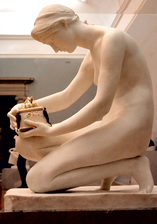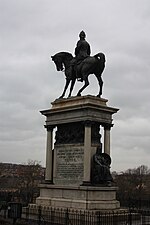Harry Bates (sculptor)
Harry Bates ARA (26 April 1850 – 30 January 1899) was a British sculptor. He was elected to the Royal Academy in 1892 as A.R.A. and was an active, if intermittent, member of the Art Workers Guild. He was a central figure in the British movement known as New Sculpture.
Harry Bates
Early life and education[edit]
Bates was born on 26 April 1850 in Stevenage in Hertfordshire. He began his career as a carver's assistant, and before beginning the regular study of plastic art he passed through a long apprenticeship in architectural decoration working from 1869 for the firm of Farmer & Brindley.[2]
Personal life and death[edit]
Bates died in poverty, having drained his finances "by his insistence on financing the Calcutta statue of Lord Roberts from his own pocket."[10] He died on 30 January 1899 at his residence, 10 Hall Road, St. John's Wood, N.W. He was buried at Stevenage on 4 February.[5]
Assessment[edit]
The 1911 Encyclopedia Britannica wrote: "The portrait-busts of Harry Bates are good pieces of realism: strong, yet delicate in technique, and excellent in character.
His statues have a picturesqueness in which the refinement of the sculptor is always felt. Among the chief of these are the fanciful Maharaja of Mysore, somewhat overladen with ornament, and the colossal equestrian statue of Lord Roberts (1896) upon its important pedestal, girdled with a frieze of figures, now set up in Calcutta, and a statue of Queen Victoria for Dundee. But perhaps his masterpiece—in which his interest in polychromy and mixed materials in a format that fused decorative art and sculpture achieved its fullest realization—was an allegorical presentment of Love and Life, a winged male figure in bronze, with a female figure in ivory being crowned by the male."[2] The 1911 Encyclopedia Britannica felt, "his premature death robbing English plastic art of its most promising representative at the time".[2]
As of 2022, the figure of Pandora is understood "as one of the many femme fatales whose deadly attraction mesmerised Victorian men."[11] While continental sculptors experimented with the ancient chryselephantine technique in the 1840s, Bates Pandora was the first chryselephantine work by a British artist.[11]: 6
Bates is primarily remembered as one of the most important sculptors working with the traditions of the decorative arts within the New Sculpture movement.
Both through his innovative use of polychromy and his allusive subject matter, he is understood to be one of primary representatives of international Symbolism within British sculpture.




![Sculpture of Homer, 1886[12]](http://upload.wikimedia.org/wikipedia/commons/thumb/3/3c/EB1911_Plate_III._v24%2C_pg.504%2C_Fig_4.jpg/523px-EB1911_Plate_III._v24%2C_pg.504%2C_Fig_4.jpg)
